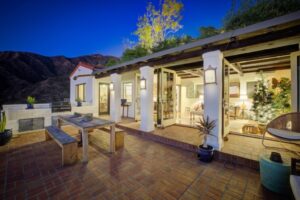Ralph Zucker on Why His Metroburb Concept Works


Ralph Zucker, the mind behind the transformation of the iconic Bell Labs facility in New Jersey, talked to Commercial Property Executive about his metroburb model and how it changed the Holmdel community.
Under his leadership, Inspired by Somerset Development brought back to life an underutilized research facility and turned it into a blend of office, retail, dining and recreation spaces that serves the entire local community—known as Bell Works.
Now, he’s replicating this “self-contained metropolis in suburbia” concept in the Chicago area, and other municipalities are already following suit. Here’s a glimpse into the future of the metroburb model.
READ ALSO: Return-to-Office Traffic Reaches Record Level
Looking back, how would you describe Bell Works’ journey?
Zucker: I was immediately captivated when I first toured the iconic Eero Saarinen-designed Bell Labs property in Holmdel, N.J., in 2008. With a background in human-scale environments, I saw immense potential in the 2 million-square-foot building, once the birthplace of groundbreaking innovations like the transistor and modern-day cell phone technology. Rather than simply serving as an office campus, I envisioned it as a vibrant hub. The central pedestrian street, slicing through the heart of the building, could be transformed into a dynamic space filled with shops, offices and public areas for community gatherings and meaningful connections.
What did it take to turn a historic property like Bell Labs into the modern place Bell Works is today?
Zucker: We spent five years obtaining the necessary approvals and entitlements to bring our concept to life. This process involved attending dozens of town hall meetings, running outreach campaigns and engaging with residents and stakeholders to demonstrate that the project was not only viable but also capable of energizing the community. To offer a glimpse of how we could transform the building into the vibrant hub it is today, we hosted a ‘block party’ in the main atrium, reimagining the space to showcase our vision of a metroburb—a place where people can shop, work, play, dine, connect, innovate and find inspiration.
What role did historic preservation play in the transformation of Bell Labs?
Zucker: The transformation that followed was meticulous. We crafted a master plan to convert the building’s interior from a single-tenant research facility into a dynamic, mixed-use space. We successfully secured historic tax credits from the National Park Service, which helped fund the renovation. As a result, the property was added to the National Register of Historic Places.

Over time, businesses began moving into the reimagined property and foot traffic increased, bringing to life the metroburb model we had envisioned years earlier. Today, Bell Works is recognized as one of the great downtowns, not just in Holmdel, but throughout Monmouth County, drawing visitors from across the state. It stands as a model for how to revitalize a sprawling, underutilized asset into a thriving hub for business and community.
Bell Works is now almost fully leased. Tell us more about the existing tenant mix and the type of spaces that are still available.
Zucker: Bell Works is home to a diverse mix of tenants, which are a large part of its unique identity as a metroburb. Today, the building houses Fortune 500 companies, startups, restaurants, retailers, fitness studios, health-care practitioners, a public library, a Montessori School and an entire indoor pedestrian street called The Block.
Most recently, we expanded our dining options with the opening of our first full-service restaurant, Mabel, just shortly after opening Miznon Kosher, a fast-causal Mediterranean eatery from celebrity chef Eyal Shani. Other recent additions to The Block include Exclusive Cuts, an upscale barbershop; ARMR Studio, a modern martial arts and self-defense training studio, and Peticures, a luxury pet spa offering premium grooming services.
While Bell Works is currently 98 percent leased, there’s still room for more businesses to join this thriving community. We offer flexible solutions for tenants of all sizes and types, enabling any company to benefit from being here. We also offer ready-to-wear office suites, providing turnkey solutions ranging from 500 square feet to 5,000 square feet, which feature unique, custom designs that balance function and style.
Did you make any changes to your leasing strategy after the pandemic to reflect tenants’ evolving preferences?
Zucker: Truthfully, not much needed to change when the pandemic hit in terms of leasing strategies, design and amenities—Bell Works was ahead of its time from the start. When we created the metroburb, our vision was to design a mixed-use office environment that offered everything people needed within one ecosystem. This concept is exactly what the post-pandemic world has come to embrace.
How did you specifically adapt to tenants’ need for more flexibility in the workplace?
Zucker: We did add new layers to the ecosystem to reflect the changing tenant preferences, especially in an era where work models are constantly evolving. We’ve prioritized flexibility by offering customizable spaces and flexible leasing options that accommodate smaller teams and a wide range of needs. In 2020, we introduced coLab, our membership-based coworking space, which provides flexible workspaces for smaller teams and startups, including shared and dedicated desks, as well as private executive suites. With skyrocketing demand, plans for coLab 2.0 are already underway.
In 2021, we launched Campus, a fully furnished, flexible leasing option for medium-size companies transitioning back to the office postpandemic, which remains fully leased today.

What do you think makes Bell Works resilient in the face of market shifts?
Zucker: It’s worth noting that there will never be a perfect, one-size-fits-all model for leasing strategies, as the market is shaped by changing business demands and workforce behaviors. We developed Bell Works with adaptability at its core, ensuring it was designed not only to meet today’s needs but also to thrive amid future market shifts.
By doubling down on what we had already been doing, we set ourselves up for success postpandemic. We were able to get people excited to return to the office because they have everything they need in one place. Want to get a workout in before work? No need to rush. Need a haircut during lunch? No problem. We’ve created a dynamic environment where people can thrive both inside and outside the office and that’s a big part of our continued success.
What role does Bell Works play in the broader Holmdel community, and how do you ensure it continues to be a welcoming space for both tenants and the public?
Zucker: At Bell Works, we’ve always aimed to create more than just a workplace. By opening the facility to the public daily from 6 a.m. to midnight, we’ve transformed it into a dynamic destination where visitors can shop, dine and engage in a variety of activities. Whether on the basketball court or the rooftop, the common theme is connection.
We also host a wide range of events and public activations, including rooftop fitness classes, a weekly Bell Works Fresh farmers market, industry conferences, community fundraisers, networking events, 5k runs around the campus and more. On any given day, Bell Works attracts up to 6,000 visitors and the best part is that not all of them are here to come to work.
READ ALSO: What’s Defining Office in 2025?
What impact has Bell Works had on the local economy and surrounding area so far?
Zucker: The redevelopment of Bell Works has significantly impacted the local economy by creating countless jobs, attracting businesses and raising awareness of the area. Transforming the former Bell Labs site—once closed to the public and exclusively for employees—into a vibrant, mixed-use development has drawn an expansive range of tenants and visitors.
This surge in foot traffic has not only bolstered local businesses but also spurred growth in the surrounding community. In fact, we’ve been able to lower taxes for Holmdel citizens thanks to our significant tax contributions to the township. We’ve also become a hub for arts and culture, hosting events like our annual Fourth of July fireworks, theatrical performances at Bell Theater and exhibitions such as the recent “The Landscape Architecture Legacy of Dan Kiley.”
How has the success of Bell Works influenced your approach to similar projects, like the Bell Works site in Illinois?
Zucker: The success of Bell Works has proven the scalability of the metroburb model, which we’ve successfully applied to Bell Works Chicagoland. The flexible office spaces at Bell Works New Jersey have been integral in shaping our approach to Chicagoland. There, we replicated the mix of office, retail, dining and amenities, while tailoring each part to fit the local market.

This careful market attention has led to a 92 percent occupancy rate on the east side, having leased the entire marketplace and more than 400,000 square feet postpandemic, with plans for a residential component.
What started as a redevelopment of an underutilized space in Holmdel has now become a model that other municipalities are eager to replicate. Our success has sparked interest from communities across the country, showcasing Bell Works as a blueprint for revitalizing former commercial properties into vibrant, mixed-use environments.
What does the future of the metroburb concept look like, and how do you see it evolving over the next five years?
Zucker: The metroburb model is certainly here to stay, but over the next five years, we expect it to evolve with a greater focus on attracting diverse tenants and enhancing lifestyle offerings. At Bell Works New Jersey, for example, we’re adding five all-season pickleball courts and planning to further develop our lower level to accommodate a potential bowling alley or spa. These additions reflect a comprehensive, 360-degree approach to lifestyle amenities that we believe will resonate strongly with our community. Building on our successes, we’re committed to delivering more of the same—but even better.
Additionally, we anticipate a stronger integration of residential components, such as the townhomes and apartments we’re adding at Chicagoland, to meet the growing demand for live-work-play environments.
What’s next for Inspired by Somerset Development?
Zucker: We’re excited to begin phase two of Bell Works Chicagoland as the east side of the building approaches full capacity. This next phase will focus on redeveloping the western portion, creating additional space for retailers, businesses and office tenants. We’re also moving forward with the residential component of the metroburb, introducing 164 townhomes and 300 apartments to provide much-needed housing for the growing community.
We’re eager to expand upon the success of our metroburb model, with plans to bring it to additional properties in the region.
The post Ralph Zucker on Why His Metroburb Concept Works appeared first on Commercial Property Executive.




